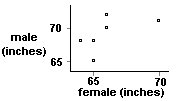http://www.john-weber.com
Class Activity #5
A student wonders if people of similar heights tend to date each other. She measures
herself, her dormitory roommate, and the women in the adjoining rooms, then she measures the
next man each woman dates. Here are the data (heights in inches):
| Women, x | 66 | 64 | 66 | 65 | 70 | 65 |
| Men, y | 72 | 68 | 70 | 68 | 71 | 65 |
- Use the TI-83 to help you construct the scatterplot.
- Describe the overall pattern. Is there an outlier?
- Based on the scatterplot, do you expect the correlation to be positive or negative? near ±1 or not?
- Compute the correlation r.
- How would r change if all the men were 6 inches shorter than the heights given in the table?
- How r would change if the heights are measured in centimeters?
Adapted from http://www.uoregon.edu/~qmshao/fall98/243ch2.pdf
ANSWERS:
- Here's the scatterplot:

- There appears to be an outlier at (70, 71). The pattern is weakly linear with a positive association.
- Based on the scatterplot, I expect the correlation to be positive but not near +1.
- r = 0.565.
- r will not change if all the men were 6 inches shorter than the heights given in the table. Check by re-entering
the data and calculating r.
- r will not change if the heights are measured in centimeters.

